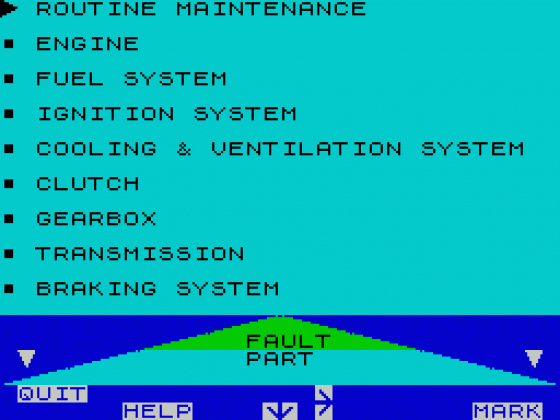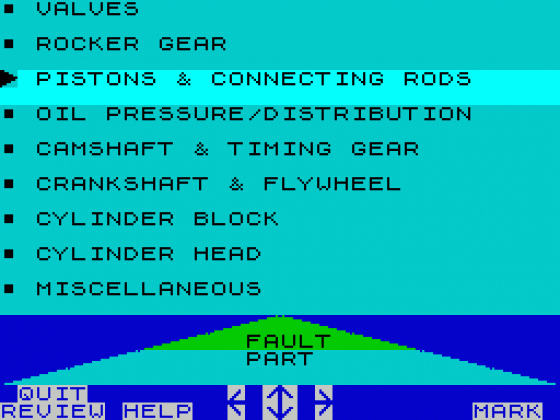
Crash
 1st May 1985
1st May 1985
Categories: Review: Software
Author: Jeremy Spencer
Publisher: Simtron
Machine: Spectrum 48K
Published in Crash #16
Car Cure
Do you ever get bored waiting for your Spectrum to load? are you tired of listening to the hums, beeps and squeaks that emanate from the recorder? You do? You are? Well Simtron have a cure (please don't get too excited), instead of having to watch a highly coloured, well drawn picture you are given a very complicated maze to solve while you wait for Car Cure to load. Nice idea but the problem is that the maze repeats itself after seven billion, five hundred and ninety seven million, three hundred and fifty thousand two hundred and eighty four times (that's 7,597,356,284), so sooner or later you'll get bored with it.
Car Cure is a serious application (we don't just review games you know, we are able to come to terms with real life situations as well as anybody, at least we like to think that we can). It's just as well that this is an expert system since its aim is to turn an idiot into a potential genius in whatever subject the system is concerned with. In this case it's rather obvious, this package deals with the field of automotive electro-mechanical malfunctions - or duff cars. The first thing that one has to consider when dealing with an expert system is the enormous amount of information that they hold. Car Cure has a 'knowledge' base of over 900 faults and 300 symptoms, so the possible combinations of results are mindblowing. Bearing in mind the complexity, I am not exactly sure how one can evaluate an expert system when one is anything but an expert. So I hit on the idea of rushing out to the car park, opening the bonnet of Sophia, my car, and ripping out a small but vital part. Pretty neat eh? But the really clever bit is I'm not going to tell myself what I've done, I will rely entirely on Car Cure to sort it all out.
After failing to solve the maze I was confronted with a page that offered options to ask for 'help' or started tracing problems relating to 'symptoms' or 'parts '.

One would use the 'parts' option if the faulty part was known. It wasn't so I chose 'symptoms'. The background turned yellow and I noticed in the user guide that the colours have been selected to help a user follow the program. The book says' ... you set out from the safe house through a cornfield of symptoms (yellow), across a river of parts (blue) into a forest of faults (green) where there is a battlefield of action (red)'. That sounds rather silly but when you come to use the program it is an aid, it also goes to show how well the program has been thought out.
Back to my problem; on the first symptom page I am given a number of options, from 'starting the engine' to 'instruments and warning lights'. Since Sophia will not start I select the first. Another yellow page giving more symptoms: 'starter won't operate'; yes it does: 'engine won't fire'; correct, so select that and yet another cornfield. I select the option that says 'spark not at spark plug HT lead' because it isn't, suddenly I'm in the river (blue for parts). This time I am offered 5 options all concerned with the ignition system.
I can choose to examine the system as a whole or look at the distributor, contact breaker, HT leads or coil and wiring. I decide to go for 'HT leads' since there is no spark there. Now I enter the forest and I am asked to check if the leads are damp, perished, loose or disconnected, hang on...............No, they seem to be fine, so back to the river and this time I select distributor because that's the bit connected to the HT leads. Again' I am in the forest (sounds a bit like Dragontorc). I am now offered a bewildering selection of options some, I can barely pronounce let alone understand, take 'rotor arm centrifugal rev-limiter defective' for example. I notice one option suggests that the 'distributor rotor arm is badly worn', it must be because there's nothing there! I ask the system what to do and the screen turns red, bearing the message 'replace with new' and 'you can handle this'. It just happens that I have a rotor arm in my pocket, what a bit of luck.

Now for the serious user there is a mode called 'extended commands'. This allows the use of more features. 'Mark' allows items on a list to be marked so that the user can keep track of items. Also if you have a a problem that has a number of symptoms one could mark the listed faults for each symptom, this would eventually leave you with a list of common faults. The 'OK' function allows the user to remove faults that have already been checked, thereby simplifying the presentation. Once a fault has been 'OK'-ed then it will not appear again in any list for any other symptom thus avoiding confusion. A trace facility allows the user to mark a fault that is suspected and then the program will trace back through the symptoms to help confirm the fault. Any fault diagnosis session can be saved to tape for use at a later date.
Most of the input for the system simply entails the use of the cursor keys or simply answering yes or no.
My own example did little to demonstrate the depth of problems that are dealt with. Car Cure is better suited to complex problems such as one would find with the gearbox, clutch or brakes. These are the problems where mortals and idiots are left floundering.
Comments
Control keys: cursor keys
Use of colour: imformative
Graphics: none
Comment 1
'There is no intention that Car Cure should replace the workshop manual, it cannot hope to present the detail required to actually carry out repairs. However it will prove valuable in the first stages of fault diagnosis, often the hardest part. Once the fault has been located a manual should be used in order to carry out the necessary work. The package works extremely well, a great deal of effort has gone into making it user friendly as well as functional. If I had to make a criticism it would be this; sooner or later the program is going to leave you with a lot of possible options to follow and no clear indication as to how they should be selected. For example if I know that the engine runs badly I am eventually presented with a parts menu that allows me to select between routine maintenance for the fuel system, carburettor, fuel pump, fuel lines and tank or fuel injection. It would have been a great help if some small indication could have been given to help me isolate the search to one of those options otherwise I will have to check for each fault under each part. Of course the fault can be isolated much more quickly if a fault has more than one symptom because complementary faults have fewer symptoms in common. On the whole I would say this was a very worthwhile package if you are one of those who can only manage to lift the bonnet and stare with awe into the engine. I shall recommend Car Cure to Lloyd, God knows he needs it!'
Other Reviews Of Car Cure For The Spectrum 48K
Car Cure
A review by Bryan Skinner (Personal Computer News)
Car Cure (Simtron)
A review by Clive Smith (ZX Computing)
Car Cure (Simtron)
A review by Bill Scolding (Sinclair User)







